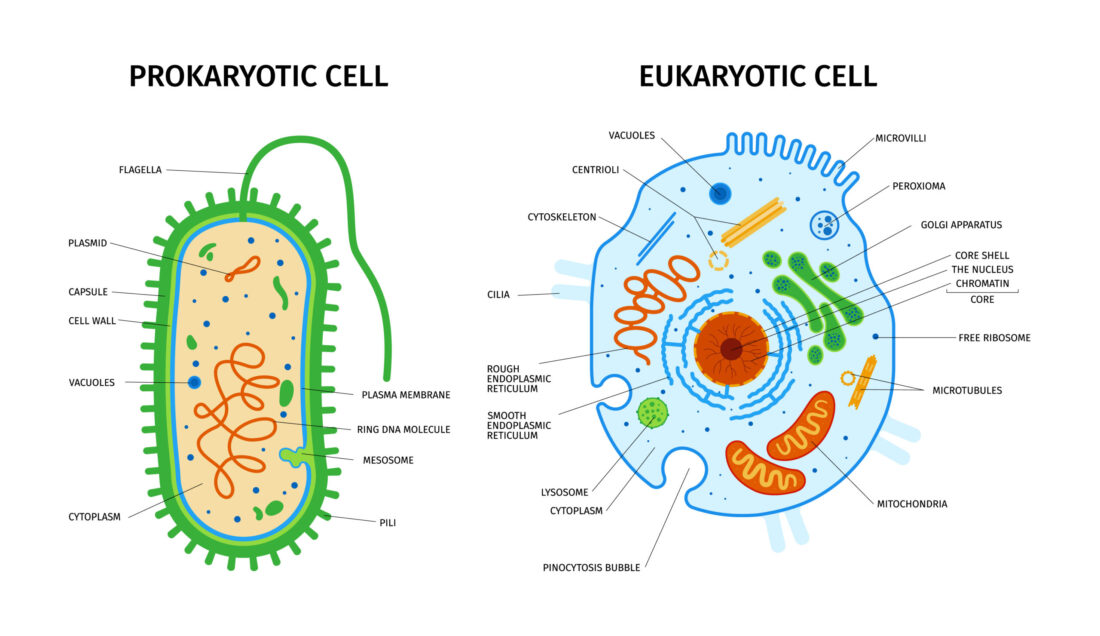In the intricate world of biology, cells come in two major types: prokaryotic and eukaryotic. These cells serve as the building blocks of life, but they differ significantly in structure and how they function. Understanding the contrasts between these cell types not only sheds light on the diversity of life but also reveals the fascinating complexity within each organism. In the article “Prokaryotic vs. Eukaryotic Cells” we’ll delve into the profound differences and intriguing cellular processes that distinguish prokaryotic and eukaryotic cells.
Prokaryotic Cells: Simplistic Yet Efficient:
Prokaryotic cells, represented by bacteria and archaea, stand as the embodiment of simplicity. These tiny cells lack a defined nucleus and various membrane-bound structures. Instead, their genetic material resides in a region known as the nucleoid, and they harbor limited organelles.
Structural Differences:
Prokaryotic cells are characterized by their smaller size, ranging from 1 to 5 micrometers. Unlike eukaryotic cells, they lack a true nucleus and other membrane-bound organelles. Their ribosomes are smaller (70S), and they often sport a cell wall made of peptidoglycan—a feature absent in eukaryotic cells.
Cellular Processes:
Prokaryotic cells reproduce primarily through binary fission, a simple asexual process where a single cell divides into two identical offspring. These cells also engage in essential metabolic processes like cellular respiration and photosynthesis, directly within the cytoplasm. Some prokaryotic cells even boast flagella, whip-like structures that enable movement.
Eukaryotic Cells: Complexity Unveiled:
Eukaryotic cells, present in plants, animals, fungi, and protists, showcase a higher level of complexity. They possess a true nucleus, numerous membrane-bound organelles, and compartmentalized cellular processes that sustain life’s intricate functions.
Structural Differences:
Eukaryotic cells are generally larger, spanning 10 to 100 micrometers in diameter. They feature a true nucleus enclosed by a nuclear envelope, and their ribosomes are larger and more intricate (80S). With a diverse range of organelles like the endoplasmic reticulum, mitochondria, and Golgi apparatus, these cells can perform specialized functions.
Cellular Processes:
Eukaryotic cells employ diverse reproduction methods, such as mitosis for somatic cells and meiosis for gametes, enabling sexual reproduction. These cells also have a compartmentalized metabolic system, with mitochondria facilitating cellular respiration and chloroplasts (in plants) executing photosynthesis. Additionally, eukaryotic cells maintain structural integrity and intracellular transport through a complex cytoskeleton.
Unlocking the Secrets of Life’s Diversity:
Prokaryotic and eukaryotic cells, though fundamentally different, serve as vital components in the intricate web of life. Their structural variations and distinct cellular processes highlight the ingenious adaptations that have arisen through evolution. By understanding these differences, we gain a deeper appreciation for the astonishing complexity and diversity present within living organisms.
In conclusion, the comparison between prokaryotic and eukaryotic cells unveils a world of contrasts, giving us a glimpse into the remarkable mechanisms that sustain life in its various forms. Whether they are the straightforward efficiency of prokaryotic cells or the multifaceted intricacies of eukaryotic cells, each type contributes to the vast tapestry of life on our planet.





Leave a Reply
You must be logged in to post a comment.